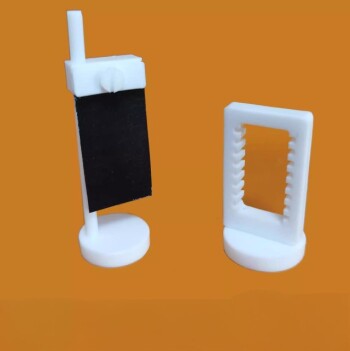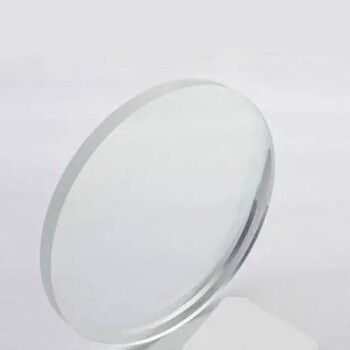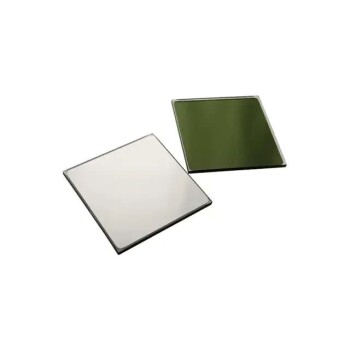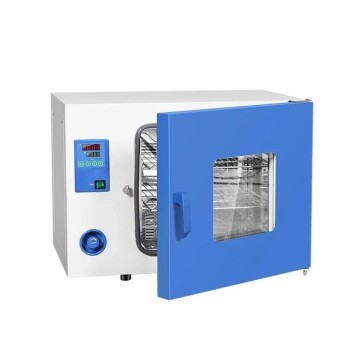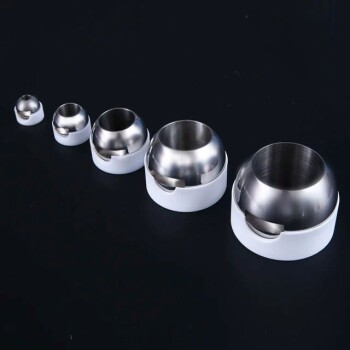간단히 말해서, 압출 흑연은 치약 튜브에서 짜내는 것처럼 탄소 재료의 페이스트를 모양이 있는 다이(die)를 통해 강제로 밀어내어 생산되는 일반적인 유형의 합성 흑연입니다. 이 공정은 재료의 내부 결정 구조를 정렬시켜 뚜렷한 방향성 특성을 부여합니다. 이는 로드, 바, 플레이트와 같은 규격 형상을 만드는 비용 효율적인 방법입니다.
핵심은 압출 공정이 이방성(anisotropic) 재료를 생성한다는 것입니다. 즉, 강도와 전도성과 같은 특성이 방향에 따라 다르다는 것입니다. 이 방향성 결함을 효과적으로 사용하려면 압출 흑연을 이해하는 것이 필수적입니다.
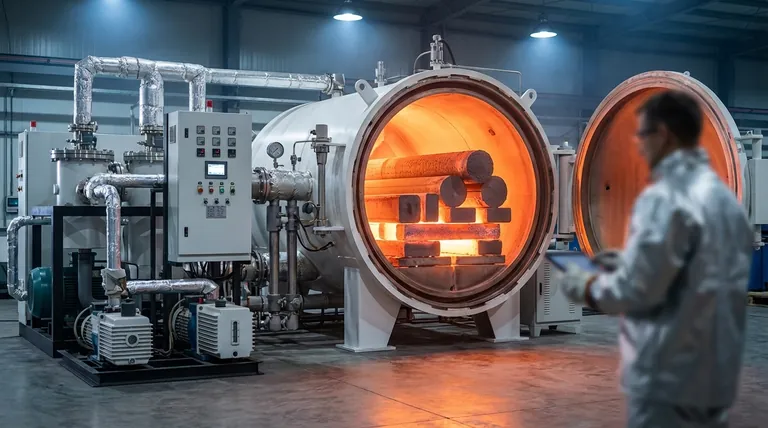
제조 공정 및 그 영향
압출 흑연의 고유한 특성은 제조 방식의 직접적인 결과입니다. 이 공정은 최종 재료에 뚜렷한 "결(grain)" 또는 방향성을 부여합니다.
### 원료에서 페이스트까지
이 공정은 소성 석유 코크스(주요 탄소 공급원)와 콜타르 피치(바인더)의 혼합물로 시작됩니다. 이 재료들을 분쇄하고 혼합한 다음 고온으로 가열하여 두껍고 유연한 페이스트를 만듭니다.
### 압출 단계
이 뜨거운 페이스트는 엄청난 압력 하에서 다이를 통해 강제로 밀려나갑니다. 다이의 모양이 둥근 로드나 직사각형 바와 같은 최종 제품의 단면을 결정합니다. 코크스의 바늘 모양 입자들이 다이를 통과하면서 압출 방향에 평행하게 정렬됩니다.
### 소성 및 흑연화
압출 후, "녹색(green)" 재료는 피치 바인더를 탄화시키고 구조를 고정하기 위해 몇 주에 걸쳐 조심스럽게 소성됩니다. 마지막 단계는 흑연화(graphitization)로, 탄소를 극도로 높은 온도(최대 3000°C)로 가열하여 비정질 탄소를 결정질 흑연 구조로 변환합니다.
압출 흑연의 주요 특성
압출 중 코크스 입자의 정렬은 재료의 거동을 정의하는 가장 중요한 요소입니다.
### 이방성 특성
흑연 결정이 정렬되어 있기 때문에 특성은 결의 방향과 수직 방향에 따라 크게 달라집니다. 열 및 전기 전도도는 압출 방향에 평행하게 측정할 때(결 방향으로) 수직으로 측정할 때(결 반대 방향으로)보다 훨씬 높습니다.
### 기계적 강도
마찬가지로 굽힘 강도와 같은 기계적 특성은 압출된 부품의 길이를 따라 더 높습니다. 이 방향성 강도는 주요 설계 고려 사항입니다.
### 열팽창
열팽창 계수(CTE) 또한 방향성이 있습니다. 일반적으로 결 방향으로 측정할 때 더 낮고 결 반대 방향으로 측정할 때 더 높습니다. 이는 고온 사이클을 포함하는 응용 분야에서 중요한 요소입니다.
상충 관계 이해: 압출 흑연 대 등방성 흑연
올바른 유형의 흑연을 선택하려면 제조 방법 간의 근본적인 상충 관계를 이해해야 합니다.
### 이방성 대 등방성
압출 흑연의 주요 대안은 등방성 흑연(isostatic graphite) 또는 "등방성 성형(iso-molded)"입니다. 등방성 성형 흑연은 분말을 모든 방향에서 금형에 압착하여 만들어지므로 무작위 결정 방향을 갖게 됩니다. 이로 인해 등방성(isotropic)이 되며, 이는 모든 방향에서 특성이 균일하다는 것을 의미합니다.
### 결정립 크기 및 가공성
압출 흑연은 일반적으로 등방성 등급보다 더 큰 결정립 크기를 갖습니다. 이는 덜 매끄러운 가공 마감을 초래할 수 있으며 정교한 디테일을 요구하는 응용 분야에는 덜 적합합니다.
### 박리(Chipping)에 대한 민감도
압출 흑연의 정렬된 결정 구조는 특히 날카로운 모서리나 취급 중에 박리 또는 층 분리(chipping or delaminating)가 발생하기 쉽습니다. 이는 로딩 및 언로딩 중에 기계적 충격이 발생할 수 있는 용광로 바닥 레일과 같은 부품에 특히 관련이 있습니다.
목표에 맞는 올바른 선택
응용 분야의 특정 요구 사항에 따라 압출 흑연의 방향성 특성이 장점이 될지 단점이 될지가 결정됩니다.
- 가열 요소 또는 전극과 같은 응용 분야에 중점을 두는 경우: 압출 흑연의 우수한 방향성 전도성과 비용 효율성으로 인해 이상적인 선택입니다.
- 도가니 또는 금형과 같은 복잡한 3D 가공 부품에 중점을 두는 경우: 안정적인 성능을 위해서는 등방성 흑연의 균일한 강도와 정밀한 마감이 필요합니다.
- 용광로 바닥과 같은 대형 구조 부품에 중점을 두는 경우: 압출 흑연의 강성과 열 특성이 유용하지만, 박리 경향이 있으므로 신중한 설계 및 취급 프로토콜이 필요합니다.
궁극적으로 재료의 고유한 결정 구조를 응용 분야의 요구 사항과 일치시키는 것이 공학적 성공의 열쇠입니다.
요약표:
| 특성 | 방향 | 특징 |
|---|---|---|
| 열/전기 전도도 | 결 방향으로 | 높음 |
| 열/전기 전도도 | 결 반대 방향으로 | 낮음 |
| 굽힘 강도 | 결 방향으로 | 더 높음 |
| 열팽창 계수(CTE) | 결 방향으로 | 더 낮음 |
| 가공성 | 모든 방향 | 마감이 덜 매끄럽고 박리되기 쉬움 |
실험실 또는 산업 응용 분야를 위한 고성능 흑연이 필요하십니까? KINTEK은 압출 흑연 및 등방성 흑연을 포함하여 특정 요구 사항에 맞춘 최고 품질의 실험실 장비 및 소모품을 제공하는 데 특화되어 있습니다. 비용 효율적인 가열 요소가 필요하든 복잡한 3D 부품이 필요하든, 당사의 전문가는 최적의 성능과 내구성을 위해 올바른 재료를 선택할 수 있도록 도와드립니다. 지금 문의하여 프로젝트에 대해 논의하고 KINTEK이 실험실 효율성을 향상시킬 수 있는 방법을 알아보십시오!
시각적 가이드
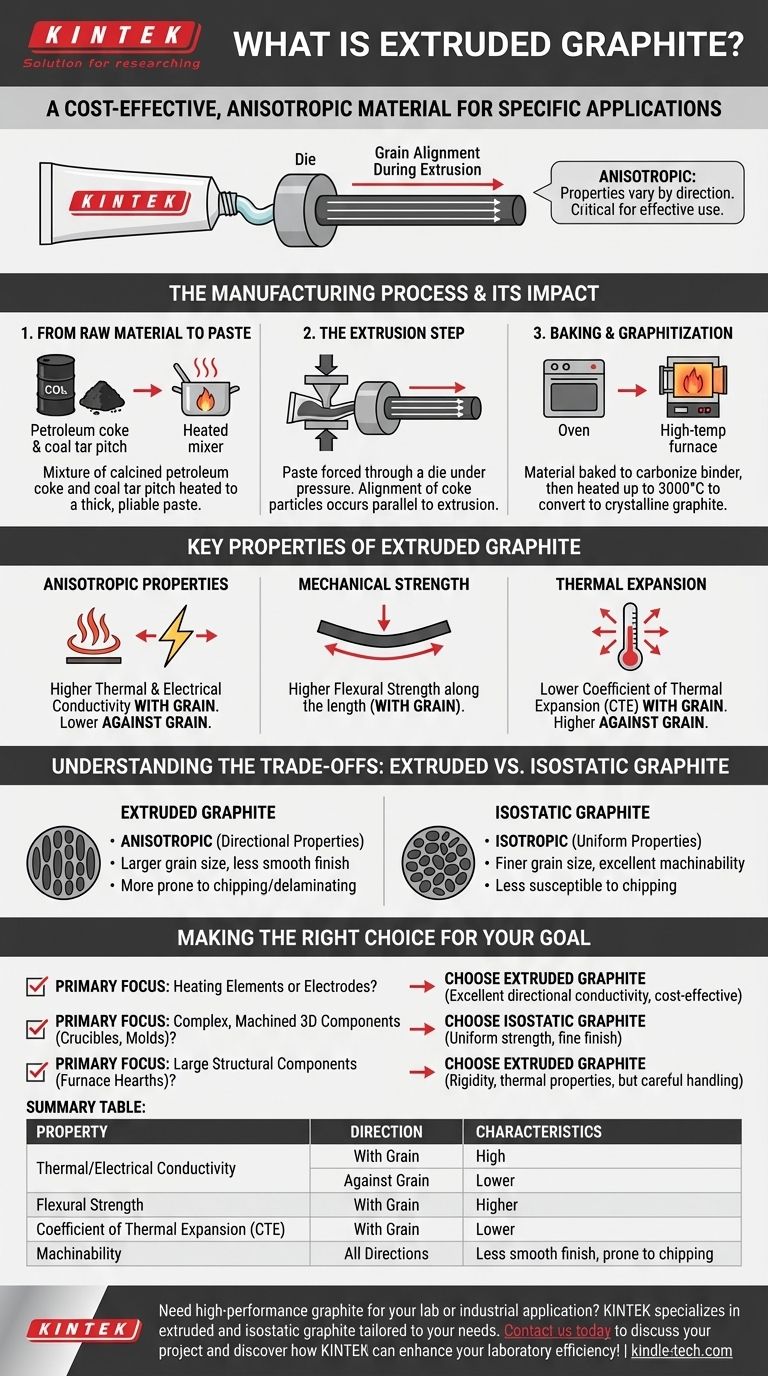
관련 제품
- 수평 고온 흑연 진공 흑연화로
- 탄소 재료용 흑연 진공로 하부 배출 그래프화로
- 수열 합성 반응기 폴리테트라플루오로에틸렌 탄소 종이 및 탄소 천 나노 성장용 맞춤형 PTFE 테플론 부품 제조업체
- 고정밀 애플리케이션용 초고진공 전극 피드스루 커넥터 플랜지 전력 전극 리드
- 배양 접시 및 증발 접시용 맞춤형 PTFE 테플론 부품 제조업체


